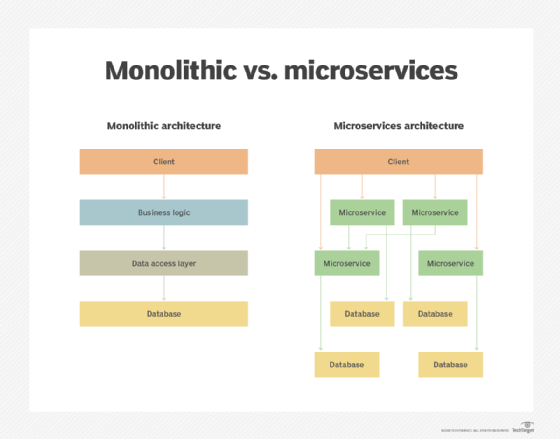
Fotolia
Improve microservices management in operations with 5 tips
Distributed applications are the future of IT, thanks to their scalability and flexibility, but growth means growing pains. Tackle microservices issues with this expert advice.
Microservices are an important development in application infrastructure, as well as architecture, particularly because they pair well with containerization.
Organizations that use microservices break their applications into small pieces that can scale up and back down -- even to practical nonexistence if not in use -- independently of each other. This setup gives IT operations better control over applications' underlying resources, such as storage and compute. But these teams also must manage microservices differently than monoliths in several key ways.
These five tips address the challenges that IT operations admins face in microservices management.
1. Data that needs to stick around
One of the biggest challenges of containerized microservices is data persistence: When the container spins down out of existence once a transaction or other task is complete, the data for that interaction disappears as well. But most organizations need the data to continue to exist in certain uses. Writer Alan Earls shares experts' tips for data planning and management strategies, as well as some tool suggestions to make the job easier.
2. This feature must talk to that feature
Where monoliths typically live on a small cluster of VMs, microservices live on hundreds or thousands of container instances and clusters. Creating communication pathways between them -- or at least between clusters of containers -- can be a complex microservices management nightmare. Twain Taylor, IT expert at Fixate IO, offers guidelines on API management among microservices to keep admins from waking up in a cold sweat.

3. Microservices need cloud-based ops
Major cloud providers AWS, Microsoft Azure and Google offer cloud-native tools and services to ease microservices development, deployment and management. Containerization is a key point of any cloud microservices strategy, and service mesh has potential to become indispensable. See which cloud providers offer the tools your organization could use most in this roundup from IT and project management professional Kenneth Milberg.
4. Microservices shake up architectures
The benefits of microservices are well-known, but risks and downsides of microservices management shouldn't be ignored. Microservices rely on increasing levels of abstraction, which means that all of the components for a working application in production can be increasingly difficult to manage and monitor. With the application's code base scattered across multiple platforms, one single change can cause the entire application to crash like a house of cards, and admins can struggle to determine where it all went wrong. In this interview, Gwen Shapira, a systems architect at Confluent, explains why businesses need to approach microservices carefully.
5. IT teams need to learn how to use container registries
Container registries aren't wish lists for distributed service management tools -- although that sounds convenient -- but rather a manifest of container images, akin to a source code repository. The registry contains container images, complete with version control and metadata, as well as a method to search through it all. This discoverability is paramount to successful microservices management because it provides organizations the ability to piece together a multitude of image combinations from the same source, achieving scalability without the loss of origin data. Kurt Marko, analyst with MarkoInsights, offers advice on how to use registries, as well as popular service options.







